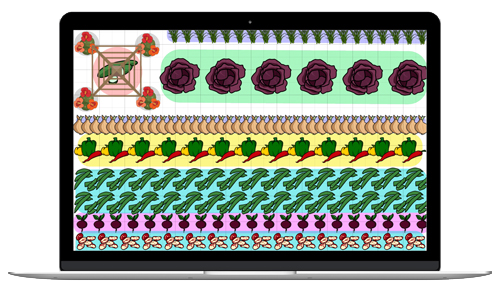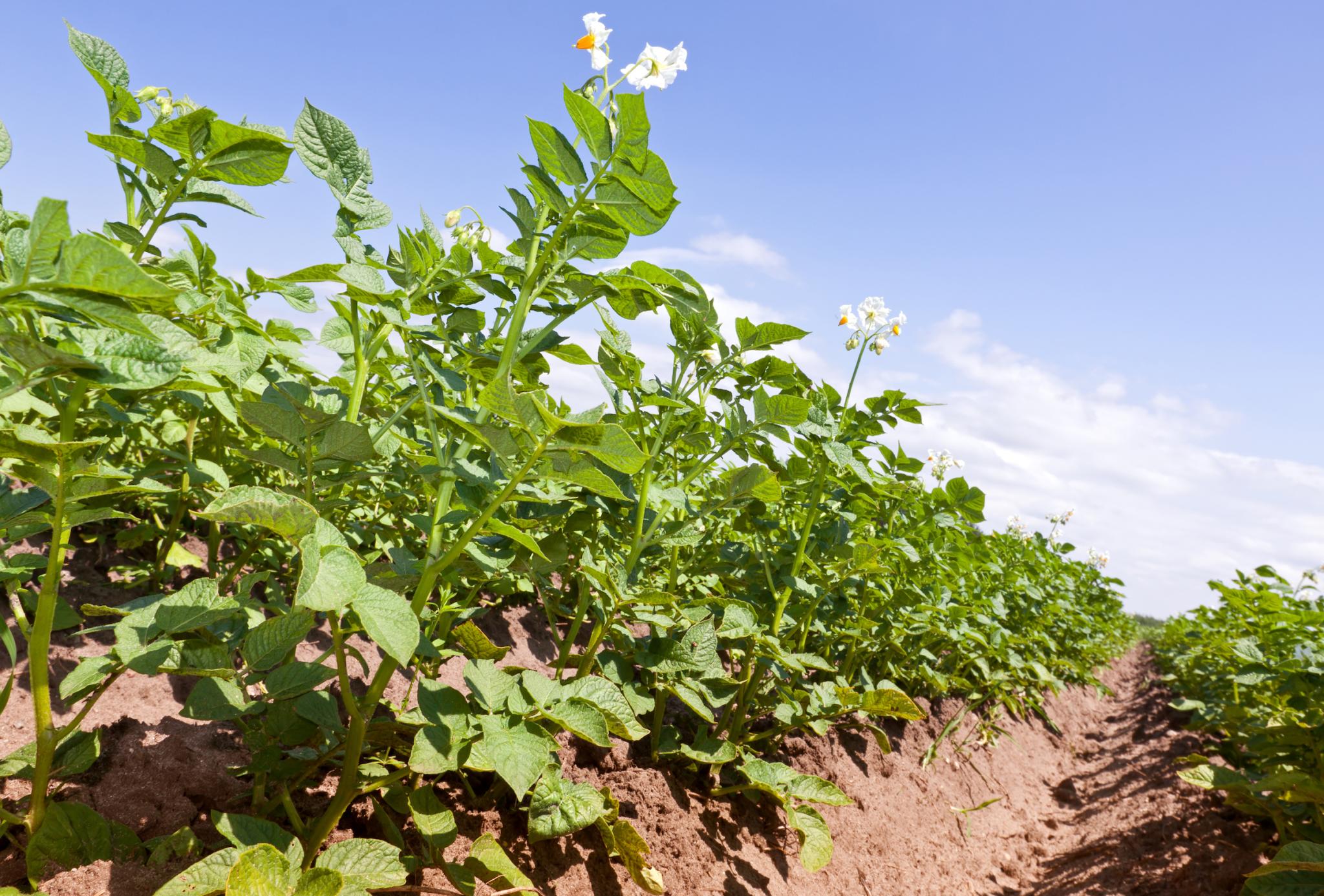
Planting, Growing, Harvesting, and Storing Potato Plants
The Almanac Garden Planner - Use It Free for 7 Days!
Plan your 2025 garden with our award-winning Garden Planner.
There are three classifications for potatoes based on when you harvest (vs. when you plant). If you harvest for storage, be sure to choose the right type:
- Early-season potatoes: first to be planted in early spring. Grow quickly (60 to 80 days), ready to harvest by early summer, tender flesh, thinner skin, store up to a few weeks.
- Mid-season potatoes (aka second early potatoes or “earlies”): mature in 80 to 100 days, typically lifted up from second half of summer, store up to a month.
- Late crops: mature in 100 to 130 days, best for storing, lasting 2 to 3 months in the right conditions; planted in August and harvested in fall.
Also, decide on the texture and flavor of your potatoes, and how you’d like to eat them:
- Dry-fleshed, mealy potatoes like russets and long white potatoes are used for baking, frying, and mashing. As mashed potatoes, they will not be gluey, and they will absorb gravy, butter or sour cream.
- Moist, waxy, round potatoes are great in soups, curries, frittatas, and salads because they don’t fall apart when cooked. You can pan-fry leftover boiled potatoes. When you mash waxy potatoes, they can become sticky.
- Red-skinned potatoes are often used for boiling or for potato salads.
Some popular potato varieties, such as ‘Yukon Gold’, fall somewhere in between truly waxy and mealy.
There are over 100 potato plant varieties! Go beyond the Idaho potato to explore more exotic and delicious options. See our article on choosing the best potato varieties!
Early Varieties:
- ‘Irish Cobbler’: tan skin, irregular shape (great heirloom potato for delicious mashed potatoes!)
- ‘Red Norland’: deep red skin, sweet, delicate flavor, great in potato salads or boiled
- ‘Mountain Rose’: red skin and pink flesh, resistant to some viruses
Mid-Season Varieties
- ‘Yukon Gold’: popular, tan skin and buttery-yellow flesh, mid to large size
- ‘Red Pontiac’: red skin, deep eyes (easiest and most adaptable red potato there is to grow)
- ‘Viking’: red skin, very productive
- ‘Chieftan’: red skin, resistant to potato scab, stores well
Late Varieties
- ‘Katahdin’: tan skin, resistant to some viruses
- ‘Kennebec’: tan skin, resistant to some viruses and late blight
- ‘Elba’: tan skin, large round tubers, resistant to blight and potato scab
- All Blue Potatoes
- ‘Fingerling Salad’ potatoes
Cooking Notes
Potatoes can be prepared in many ways: boiled, mashed, cut into pieces and roasted, french-fried, scalloped, made into dumplings or pancakes, grated into hash browns, and even brewed as alcoholic beverages.
Most potato dishes are served hot, but some are first cooked, then served cold, notably potato salad and potato chips.
ADVERTISEMENT
The point of mounding, or hilling, is to be sure that any potatoes that grow near the surface of the soil do not get exposed to the sun. If they do, they will turn green and not edible. You can stop when the foliage begins to die off.
Grew potatoes as a child, now doing my own for first time in 25 years. Potatoes doing great but just noticed some side sprouts coming up around the hill. almost like you would see with raspberries. do I let these side sprouts come up or clip them?
Let the side sprouts be—they may help produce more potatoes. When the shoots become of suitable length, you might want to partially cover them with soil or mulch just as you do the hilling for the rest of the plant.
Is it possible to add pictures of how potatoes should look at each stage. I enjoyed reading your article but for those of us amateurs a picture is worth a thousand words :-) I planted my seeds about 11 weeks ago. They leaves look good I hilled a little. When should I pull them up? If I pull them too soon can I pack it back down? This is my first year. I did about 8 plants.
We agree that pictures are always a big help. Thanks for the suggestion!
To get the biggest and best potatoes, harvest only after the foliage has started to die back. How long this takes depends on which type of potato you’ve got: early-, mid-, or late-season potatoes. When you see foliage turning yellow, cut it to the ground and wait 10-14 days before harvesting. (This will allow the potatoes to form a good protective layer.)
My sweet 6 year old son went down in our garden today and "weeded" a 40' row of Yukon gold potato plants. He thought that since potatoes grew in the soil, that the top must be weeds. He managed to pull all the plants up and leave some amount of root on most of the plants. My question is: I immediately planted them all back in the ground with in the hour. What is the likelyhood of them surviving and coming producing potatoes?
How far along were the plants? It is really hard to know, but worth a try to see if they will grow back. The plants may go through shock, and wilt a bit at first; it may take a little while to recover, if they can. However, it is possible that the leaves can produce food enough to grow new roots. It is important, though, that some of those existing roots are healthy, to draw in water etc. Keep an eye out for any stresses, such as pests and diseases, and maintain good cultural conditions to baby the plants to help them recover, if possible. If the day is especially hot, you might provide a little partial shade (or place under row cover) during the peak of the heat until plants re-establish. Good luck!
Hello! Thanks for the helpful information on your site. If there's one thing from NZ that I miss, it is the melt-in-your-mouth deliciousness that are Jersey Benney new potatoes, grown in the Otago region. They are truly a gift of the earth! I now live in Arkansas and would LOVE to know if there are any potato varieties comparable to the Jersey Benney, here in the US? If so, where can I buy these as seed potatoes? It would be awesome if I could grow some next year.
Thanks again!
Pip
Unfortunately, I’m not familiar with Jersey Benne, but it appears that it is an early type, with waxy flesh, good for new potatoes, salads, boiling? If so, you might ask your local garden center or county’s cooperative extension for that type of variety that would grow well in Arkansas. For contact info, go to:
http://www.almanac.com/content/cooperative-extension-services
In general, ‘Yukon Gold’ is a popular yellow potato, but grows a little later than the first or second earlies (midseason). Not quite as waxy, but valued for its flavor. ‘Red Luna’ is said to be flavorful. Other options might be ‘Dark Red Northland’, ‘Red Gold’, or other red potatoes often grown as new potatoes. There are also heirloom varieties that might be fun. Good luck!
I have a problem with potato bugs. They are not the flea beetle. What can I do other than check every plant every day and remove them by hand?














